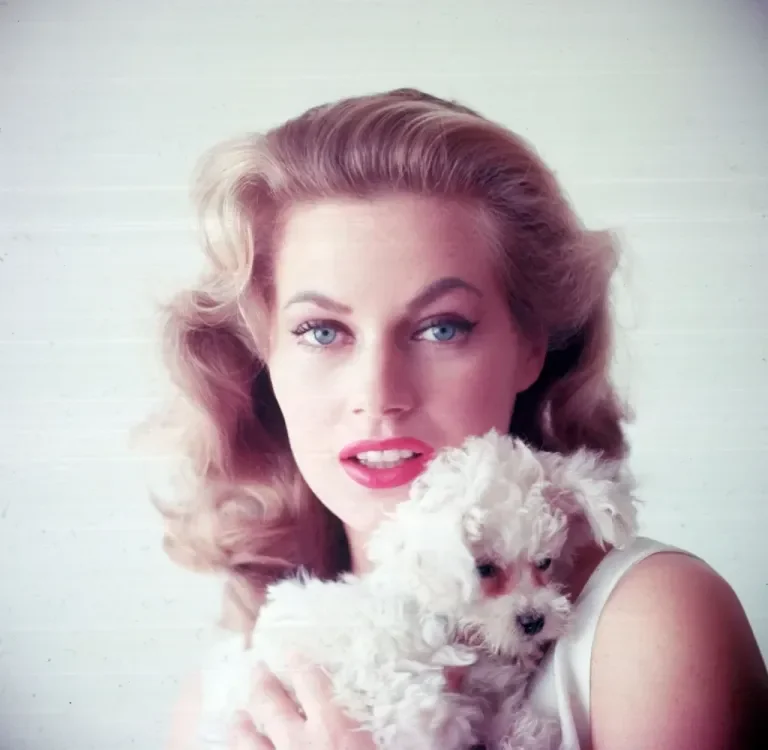Born on September 29, 1931, in Malmö, Sweden, Anita Ekberg grew up in a modest household as the sixth of eight children. Though her early years gave little hint of the international fame that awaited her, her striking beauty set her apart from an early age.

Her journey to stardom began in 1950 when she won the title of Miss Sweden. While she didn’t take home the Miss Universe crown, her participation in the pageant proved to be a turning point. The exposure brought her to Hollywood, where her captivating presence quickly caught the eye of industry insiders. This newfound recognition opened doors in modeling and acting, setting the stage for her entertainment career.
Breaking into Hollywood

Ekberg’s Hollywood debut came in the mid-1950s with supporting roles in films such as Blood Alley (1955), where she appeared alongside John Wayne and Lauren Bacall, and the comedy Artists and Models (1955), starring Dean Martin and Jerry Lewis. Her Nordic beauty and statuesque elegance earned her the nickname “The Iceberg,” reinforcing her image as a classic Hollywood bombshell. Popular media, including Playboy, frequently featured her, further cementing her status as a pop culture sensation.
La Dolce Vita and Global Stardom

However, it was her role in Federico Fellini’s La Dolce Vita (1960) that made her an international icon. Her portrayal of Sylvia, the enchanting yet elusive starlet, captured the essence of celebrity allure and mystery. The film’s most legendary moment—Ekberg wading through Rome’s Trevi Fountain in a flowing black gown—became one of the most enduring images in cinematic history.
Despite the worldwide recognition La Dolce Vita brought her, the role also led to typecasting, with many directors offering her parts that emphasized her glamorous persona. While this limited her opportunities for more diverse roles, Ekberg embraced the fame it afforded her, understanding the power of the image she had cultivated.
Life in Italy and Career Beyond Hollywood

Choosing to remain in Italy after her rise to stardom, Ekberg found greater creative freedom outside Hollywood’s constraints. She appeared in notable European films such as Boccaccio ’70 (1962), an anthology featuring works by Fellini and Vittorio De Sica, and 4 for Texas (1963), where she reunited with Dean Martin and Frank Sinatra. Though filmmakers often cast her in roles that leaned into her seductive image, she maintained a strong presence in European cinema, solidifying her legacy as a screen siren of her era.
THE DAY I LEARNED WHAT TRUE STRENGTH LOOKS LIKE

The sun beat down mercilessly, reflecting off the asphalt in shimmering waves. Sweat stung my eyes as I wrestled with the last stubborn lug nut. Another long day on the construction site, another day spent pushing my body to its limits. I was used to it. I was a construction worker, built like a bull, and pride myself on my strength. I could lift steel beams that would make most men wince, and I never backed down from a challenge.
Thirst gnawing at my throat, I stopped at the gas station, the promise of an icy soda beckoning. As I stepped out of my truck, I noticed an elderly man struggling with his car. His back was to me, but I could see his shoulders hunched, his hands trembling as he wrestled with a tire iron. Sweat stained his shirt, and he looked utterly defeated.
Something in his posture, the way his shoulders slumped, the way he seemed to shrink under the weight of the situation, tugged at my heartstrings. I walked over, a question forming on my lips. “Need a hand?”
He startled, turning to face me. His eyes, the color of faded denim, were filled with a mixture of surprise and apprehension. For a moment, he just stared, as if deciding whether to trust this hulking stranger. Then, a flicker of something akin to surrender crossed his face. “Yeah,” he rasped, his voice rough with exertion, “I think I do.”
As I knelt down, loosening the stubborn lug nut, he began to speak. His voice was weathered, like an old leather boot, but surprisingly steady. “Name’s Arthur,” he introduced himself. “Never been one to ask for help,” he confessed, his gaze fixed on the ground. “Always been the one doing the fixing, the helping.”
He went on to tell me about his life – a life of hard work, of providing for his family, of always being the strong one. His wife, bless her soul, had passed away last year, leaving a gaping hole in his life. “She always told me,” he sighed, “not to be so stubborn. To ask for help when I needed it. But I… I never could. Pride, I guess.”
As I tightened the last lug nut, I looked at him. Arthur was watching me, a flicker of something akin to awe in his eyes. “You don’t know what this means to me,” he said, his voice thick with emotion.
And in that moment, I realized something profound. True strength wasn’t just about brute force, about lifting heavy things and overcoming physical obstacles. True strength lay in acknowledging your limitations, in recognizing when you needed a helping hand, and in having the humility to accept it. It was about recognizing that asking for help wasn’t a sign of weakness, but a sign of strength.
Arthur, in his vulnerability, had taught me a valuable lesson. That day, I not only helped an elderly man change a tire; I learned a valuable lesson about true strength, a lesson that would stay with me long after the memory of the hot summer day and the rusty tire iron faded.
From that day forward, I approached my work with a newfound perspective. I learned to appreciate the value of teamwork, to recognize the strengths of my colleagues, and to ask for help when I needed it. I learned that true strength wasn’t about being invincible, but about knowing when to lean on others and allowing yourself to be vulnerable. And every time I faced a challenge, I would remember Arthur, and the valuable lesson he taught me about the true meaning of strength.



Leave a Reply